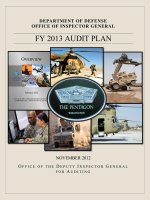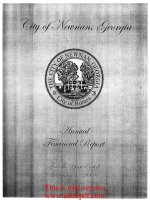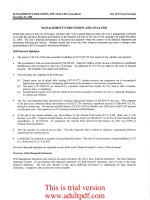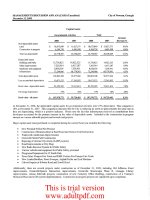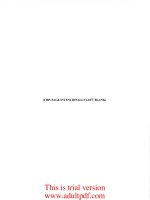Office of the Governor Financial-Related Audit For the Two Calendar Years Ended December 31, 1998 July 1999 _part2 potx
Bạn đang xem bản rút gọn của tài liệu. Xem và tải ngay bản đầy đủ của tài liệu tại đây (38.82 KB, 10 trang )
Office of the Governor
7
related to the business portion of the trip. For instance, an employee attended a
conference in Las Vegas that ended at noon on Friday, but the employee did not return to
Minnesota until the next day. The office paid the additional meals and lodging charges of
$128. The out of state authorization form did not provide a cost/benefit analysis
justifying that the additional costs were due to a lower airfare on the following day. Also,
if the extended stay was business related, the out of state authorization form did not
provide documentation to support it.
Office staff generally make their own travel arrangements. Typically, lodging and meals are
reimbursed to the employee while airfare is directly paid by the office. Out-of-state travel is
authorized by the Governor’s chief of staff and office manager, and forwarded to the
administrative services unit for payment. The office incurred about $110,000 in out-of-state
travel costs during the two-year audit period. The office could have saved a portion of these
travel costs by planning trips at least ten days in advance of the trip to take advantage of cheaper
airfares.
Recommendations
• The Office of the Governor should complete the out-of-state travel
authorization form at least ten days prior to the trip. Office staff should plan
trips sufficiently in advance to take advantage of reduced airfares.
• The Office of the Governor should document events, such as employees
combining business and personal travel, and justify the cost-benefit of
incurring additional travel costs on the out-of-state travel authorization form.
The office should document an analysis of expenses to ensure no additional
costs are incurred as a result of personal travel.
Office of the Governor
8
This page intentionally left blank.
Office of the Governor
9
Chapter 3. Administrative Expenditures
Chapter Conclusions
The Office of the Governor accurately paid and recorded rent based on
authorized lease agreements and memberships based on amounts invoiced by
various organizations. The office designed and implemented internal controls
to provide reasonable assurance that supply and equipment transactions were
accurately paid and recorded in the accounting system and in compliance with
applicable procurement requirements and management’s authorization. For
the items tested, the Governor’s Office accurately billed and deposited
reimbursements for the use of the Governor's residence. However, the
residence did not retain documentation to ensure it billed out all non-state
events for the Residence User Fund.
In addition to salaries and travel expenses, the Governor’s Office incurred other administrative
costs for rent, department membership dues, and supplies and equipment. Certain costs for
operating the Governor’s residence are reimbursed through the Governor's Residence User Fund.
Rent
The Governor's Office rented office space and equipment and also rented miscellaneous items
primarily used for functions at the Governor's residence. For local operations, the office rented
space in the State Capitol and in the Administration Building. It also rented space for its
Washington, D.C. office. Table 3-1 shows the annual rent expenditures incurred by the
Governor's Office for fiscal year 1998.
Table 3-1
Office of the Governor
Summary of Rental Expenditures
For the Year Ended June 30, 1998
Description Amount
Rent – State-Owned Space $244,393
Rent – Washington D.C. Office 37,399
Miscellaneous Rental 15,534
Total $297,326
Source: Minnesota Accounting and Procurement System (MAPS).
Office of the Governor
10
Membership Fees
The Governor’s Office pays for national memberships that have a direct benefit to the state and
not just the Governor. Membership in these organizations provides a forum for states to discuss
issues relating to shared resources and shared problems in an effort to jointly resolve the issues.
The Legislature appropriated funds to the Governor's Office for membership in the National
Governors Association and the Council of Great Lakes Governors. In addition, the office funded
a third membership, in the Upper Mississippi River Basin Association, from its regular
appropriation. The Office of the Governor paid $166,750 for national memberships, dues, and
fees during fiscal year 1998 as shown in Table 3-2.
Table 3-2
Office of the Governor
Summary of Membership Dues and Fees
For Fiscal Year 1998
Membership Organization Amount
National Governors Association $100,000
Upper Mississippi River Basin Association 35,000
Council of Great Lakes Governors 30,000
Other 1,750
Total $166,750
Source: Minnesota Accounting and Procurement System (MAPS).
Supplies and Equipment
The Governor’s Office spent $151,449 for various supplies and equipment during the year ended
June 30, 1998. The office purchased various office supplies, generally from the Central Stores
Division of the Department of Administration, to support office operations. It also purchased
and shipped office supplies to the Washington, D.C. office. In addition, the Governor's Office
purchased goods for the Governor's residence, such as supplies for cleaning and maintenance of
the residence. Food and beverages were purchased for the Governor's family consumption and
for events held at the residence. The Governor reimbursed the state for the food his family
consumed based on a monthly formula. The office also purchased awards, pictures, and flowers
for public recognition or gratitude through the Governor's necessary expense account.
Governor's Residence
The State of Minnesota maintains and operates a Governor's residence at 1006 Summit Avenue
in St. Paul. Its use is defined in Minn. Stat. Section 16B.27, Subd. 1, as follows:
The governor's residence must be used for official ceremonial functions of the
state, and to provide suitable living quarters for the governor of the state.
However, non-state functions are allowed if reimbursement is obtained and deposited in the
Governor’s Residence User Fund. Private events held at the residence during the audit period
Office of the Governor
11
included two wedding receptions, nonpolitical fund raising events, various political meetings,
events to honor various dignitaries, and a high school dance. The Governor's office collected
reimbursements of approximately $72,000 for events held during the audit period.
A residence manager plans and budgets all of the activities held at the residence. The manager
oversees seven full-time staff that clean, prepare meals, and maintain the residence. The
Governor's Residence Council is responsible for soliciting gifts for furnishings and the
restoration of the residence. We did not examine the financial activities of the Governor's
Residence Council as part of this audit. However, we recently conducted a separate audit of the
council for the period July 1, 1995, through December 31, 1998.
Audit Objectives and Methodology
We focused on the following objectives during our audit of administrative expenditures:
• Did the Office of the Governor accurately disburse and properly record rents and
memberships in accordance with lease agreements and amounts invoiced?
• Did the Office of the Governor design and implement internal controls over supplies and
equipment to provide reasonable assurance that expenditures were accurately paid and
recorded in the accounting system, and in compliance with applicable procurement
requirements and management’s authorization?
• Did the Office of the Governor properly bill and collect reimbursements for non-state
events held at the residence?
To meet these objectives, we interviewed staff from the Office of the Governor and the
Department of Administration to gain an understanding of the disbursement process and
reimbursement procedures for the Residence User Fund. We compared rent payment
transactions to authorized leases and membership payments to authorized invoices. We analyzed
supply and equipment expenditures, performed detailed tests of transactions, and tested
compliance with procurement requirements and management’s authorization. We tested user
fund transactions for proper billing and deposit of reimbursements for non-state events held at
the residence.
Conclusions
The Office of the Governor accurately paid and recorded rent based on authorized lease
agreements and memberships based on amounts invoiced by national and Midwest
organizations. The office designed and implemented internal controls to provide
reasonable assurance that supply and equipment purchases were accurately paid and
recorded in the accounting system and in compliance with applicable procurement
requirements and management’s authorization. For the items tested, the Governor’s
Office accurately billed and deposited reimbursements for the use of the Governor's
residence. However, the residence did not retain documentation to ensure it billed out all
non-state events as discussed in the following finding.
Office of the Governor
12
3. The Office of the Governor did not retain documentation to ensure that all non-state
events were properly billed out.
The Office of the Governor did not retain a control log that identified all formal events held at
the Governor’s residence. The log distinguished public versus private events and provided
management assurance that all non-state events were billed out. The office has a structured
process to plan, budget, and accumulate costs for billing out non-state events once identified as
reimbursable. However, the residence manager did not retain the master list of events nor retain
documentation supporting events that were not reimbursed. Typically, all other financial records
are transmitted to the accounting section of the Governor’s office. The event log should be
forwarded and retained in a similar fashion.
The Governor’s Office Operating Procedure 06:06:01 requires users to reimburse the Governor's
Office for events that do not serve a state benefit or purpose. With input from the Governor and
his family, the residence manager schedules events to be conducted at the residence. By
reviewing the residence budget and purpose of the event, the manager decides whether the
Governor's Office will fund a specific event or require the user to reimburse the cost of the event.
Without documentation identifying all events held at the residence, the office could not
determine if it billed out all non-state events considered reimbursable.
Recommendation
• The Office of the Governor should retain the events log identifying both state
and non-state events held at the residence. The log should be forwarded to
the accounting section for review and storage.
Office of the Governor
13
Chapter 4. Governor-Elect Transition Funding
Chapter Conclusions
Governor-elect Ventura received funding from Governor Carlson and the
Department of Administration to pay for transition office operating costs. The
Governor-elect also solicited donations which were subsequently determined to
be unneeded and properly returned to the donors or, if anonymous, deposited
into the state’s General Fund. We also found that the Governor’s Office and
the Department of Administration properly procured goods and services, and
accurately paid vendors and recorded transition office expenditures in the
accounting system.
Jesse Ventura won the November 1998 election for Governor and was sworn into office on
January 4, 1999. In order to be fully operational by January, Governor-elect Ventura needed to
use the interim time to begin assembling his administration. He had to hire staff and prepare for
the upcoming legislative session. He also attended out-of-state meetings held for new governors.
To accomplish these activities, the Governor-elect formed a transition team. Because Governor-
elect Ventura did not take office until January, he could not use his portion of the Governor’s
Office appropriation to fund activities during the interim.
To help fund transition costs, the Department of Administration received an appropriation from
the state Legislature. The department allocated $50,000 to the Governor-elect’s transition office.
The department had the responsibility to ensure that the office spent the funds in accordance with
state guidelines. The department paid the bills and recorded the transactions on the state’s
accounting system (MAPS). The entire $50,000 was used for transition office costs.
The Governor-elect concluded that $50,000 would not be sufficient to fund his transition costs
and he solicited donations from the general public. He requested that individual donations not
exceed $2,000, and specified that he would return unneeded funds. The Governor-elect raised
donations totaling $113,323 to fund the transition. Subsequently, however, the Governor-elect
determined he did not need the donations and the Department of Administration returned them,
without interest, to the donors in March 1999. The department deposited $22 from two
anonymous sources, and the interest earned on the donations, to the General Fund.
Governor-elect Ventura did not need the donation funding because Governor Carlson authorized
the use of an additional $100,000 for transition activities of the Governor-elect. As of March
1999, the transition office spent $85,415 and had outstanding obligations of $3,536.
The Governor-elect spent the transition money on administrative expenditures, primarily for
payroll costs. Table 4-1 summarizes the expenditures paid by the Governor’s Office and
Department of Administration.
Office of the Governor
14
Table 4-1
Governor-Elect Ventura Transition Funding
Summary of Expenditures
March 1999
Expenditure Type
Department of
Administration
Governor’s
Office Total
Personal Services $43,055 $48,193 $91,248
Rents and Leases 644 2,822 3,466
Repairs 78 5,399 5,477
Printing and Binding 0 1,612 1,612
Communications 1,141 8,028 8,169
Travel – In State 656 665 1,321
Travel – Out of State 2,333 0 2,333
Supplies and Materials 1,766 10,277 12,043
Equipment 0 463 463
Other Operating Costs 327 11,492 11,819
Total Expenditures $50,000 $88,951 $138,951
Source: Transition expenditure and obligation reports prepared by the Governor’s office staff.
Audit Objectives and Methodology
We focused on the following objectives during our review of transition expenditures for the
Governor-elect:
• What funding sources were obtained from the former Governor’s administration to
finance transition office expenditures of the Governor-elect?
• Did the Department of Administration properly account for and process transition
donations?
• Did the Office of the Governor and Department of Administration properly procure
goods and services, accurately pay vendors, and properly record transition office
expenditures in the accounting system?
To meet these objectives, we interviewed staff from the Office of the Governor and Department
of Administration to gain an understanding of transition funding sources and the disbursement
process. We performed tests of detailed transactions and balances. We reviewed documentation
supporting the accounting transactions, substantiated account balances, and determined the
validity of summary information.
Conclusions
Governor-Elect Ventura received funding from Governor Carlson and the Department of
Administration to pay transition office expenditures. The Governor-Elect also solicited
donations which were subsequently determined to be unneeded and properly returned to
Office of the Governor
15
the donors. The interest earned on these donations and $22 from anonymous sources
were deposited into the General Fund. We concluded that the Governor’s Office and the
Department of Administration properly procured goods and services, and accurately paid
vendors and recorded transition office expenditures.
Office of the Governor
16
This page intentionally left blank.
